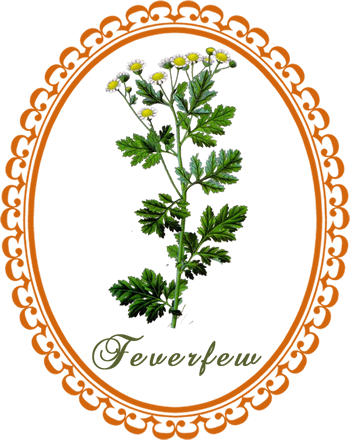
Feverfew: modern herbalists favour feverfew in the management of migraines. Taken regularly every day, it reduces both the frequency and severity of attacks for about seven out of ten sufferers...
Common Names: Feverfew
Botanical Name: Tanacetum parthenium
Family: Asteraceae
Plant Type: Hardy, evergreen perennial
Parts Used: Leaves
Flowering: July
Feverfew is native to central and southern Europe, but has been introduced and naturalized in most parts of the temperate zone, including North America. It thrives in dry, stony soils along roadsides and woodland borders and in abandoned places.
Description: Feverfew has small daisylike flowers with white outer rays and a yellow centre that is almost flat. It grows about two feet tall with slightly hairy leaves four inches long that alternate along the stem. The whole plant has a bitter smell that is avoided by bees.
Cultivation: Feverfew is a common weed of hedgerows and waste places, usually as a garden escapee. It is hardy to zone 5 and will grow in average, well-drained soil in sun or part shade, at a pH of 6.3. It self-seeds readily, and once established, it will continue to thrive.
Harvesting: The leaves are best picked before the flowers appear; harvest the flowering tops in midsummer. The leaves are best used fresh, but they can be frozen for winter use.
Feverfew Magick
Protection.
Gender: Masculine
Planet: Venus
Element: Water
Carry feverfew for protection against colds, fevers and accidents.
Burn the dried leaves as incense to fill the room with a peaceful atmosphere.
Gather feverfew leaves at the time of the summer solstice when it is at its most powerful.
Herbal Healing with Feverfew
Medicinal Actions: Abortifacient, anti-inflammatory, antiseptic, antispasmodic, carminative, depurative, emmenagogue, febrifuge, laxative, sedative (mild), stomachic, vermifuge
Medicinal Uses: Feverfew is an excellent remedy for migraines. Although the reasons for the success in treating migraines is unclear, it is most likely due to the naturally occurring combination of the active constituents of the herb, which are anti-inflammatory, antihistamine, and cause the blood vessels in the head to open up. Use other anitmigraine herbs, such as Stachys (Wood Betony), Verbena, and Rosmarinus (Rosemary) for greater effect. The best way to take feverfew is to eat from one to four fresh leaves daily, added into a sandwich to disguise the taste. The anti-inflammatory property of feverfew can also help relieve acute bouts of rheumatoid arthritis, painful periods, and sluggish menstrual flow.
Contraindications:
- Avoid during pregnancy because of its stimulant action on the uterus.
- People with a hypersensitivity to other members of the Asteraceae family, such as chamomile, ragweed and yarrow.
- Feverfew may interact with aspirin and other blood-thinners to increase blood thinning capabilities.
- If feverfew is taken for any length of time as a medicinal herb, sudden discontinuation can result in a withdrawal syndrome consisting of headache, irritability, trouble sleeping and joint pain.
Adverse effects include: gastrointestinal distress, mouth ulcers, and antiplatelet actions.
Body Care with Feverfew
To ease dragging period pain, take 1 cup weak feverfew leaf infusion up to three times daily, as needed.
- To soothe digestive spasms, apply a feverfew poultice to the abdomen, as required.
Infusion: 1 teaspoon dried or 2 teaspoons fresh feverfew leaves in 1 cup just-boiled water. For a weak infusion, use 1/2 teaspoon dried or 1 teaspoon fresh leaves in 1 cup of just-boiled water.
Poultice: Saute 2 handfuls fresh feverfew leaves in a little oil, and apply hand-hot to the affected area.
Source: The Essential Herbs Handbook by Leslie Bremness
If you appreciate the information provided,
please help keep this website running. Blessings!
© 2008-2025 aromaworx.ca. All rights reserved.

